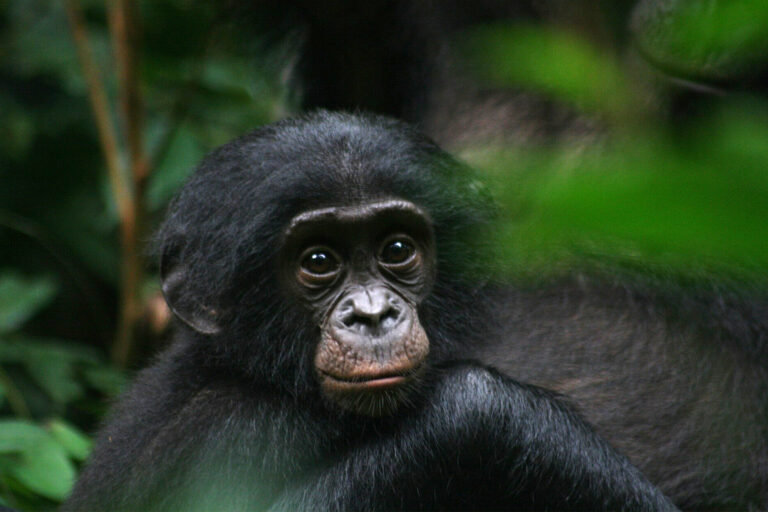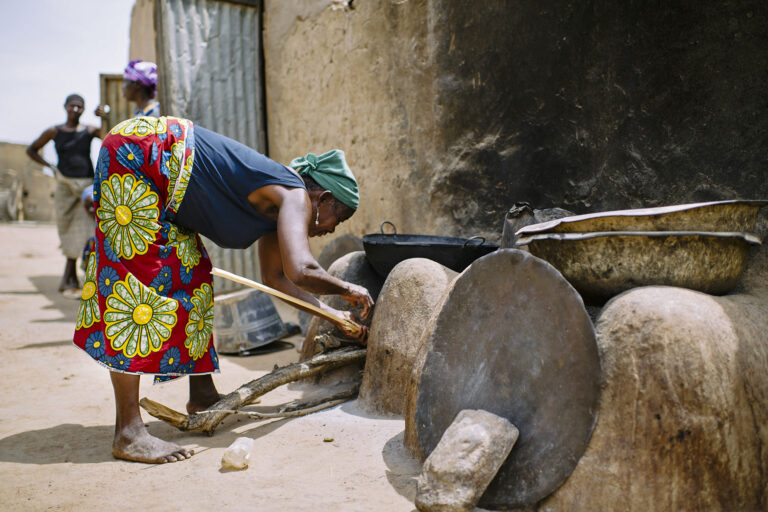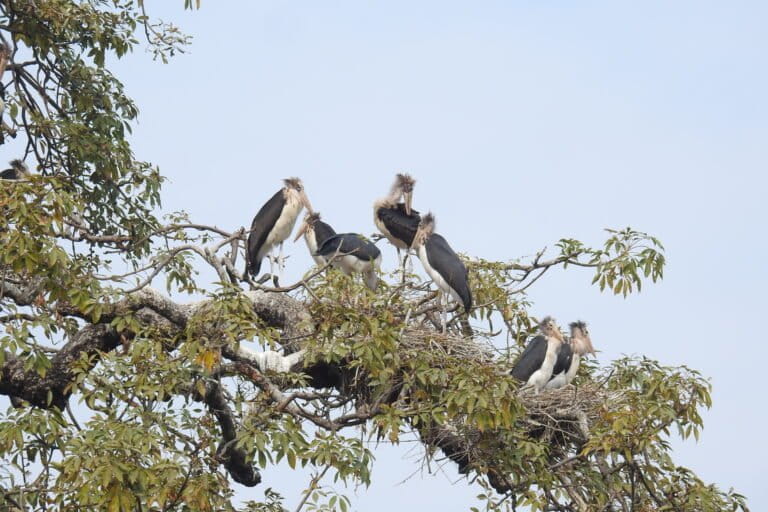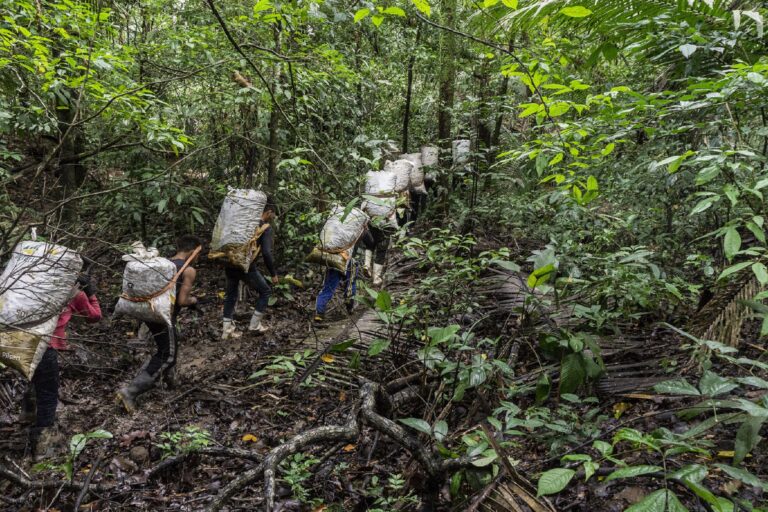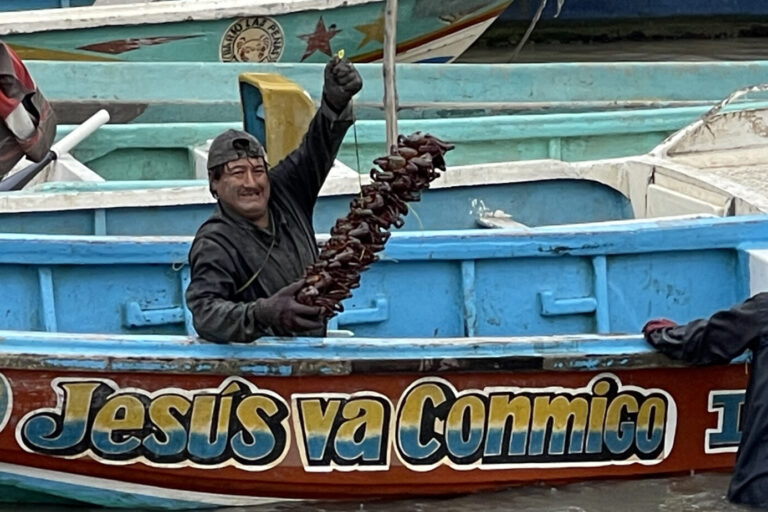The decades-long conflict in Cambodia devastated not only the human population of the Southeast Asian country but its biodiversity as well. The conflict led to widespread declines of species in the once wildlife-rich nation while steering traditional society towards unsustainable hunting practices, resulting in a situation where wildlife is still in decline in Cambodia, according to a new study from researchers with the World Wildlife Fund (WWF).
Although many biodiversity hotspots have seen their share of conflict—the Democratic Republic of Congo (DRC), Liberia, Vietnam—the relationship between war and conservation has rarely been studied. Social scientist Michael Mascia with WWF and Colby Loucks, Deputy Director of the WWF’s Conservation Science Program interviewed Cambodian villagers to understand the impacts of war on village’s surrounding wilderness.
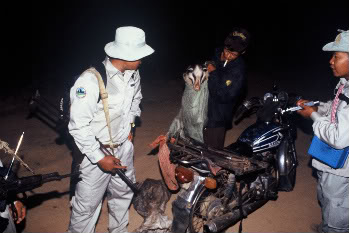 Bokor National Park, Cambodia. Heavily armed forestry rangers and their Australian security consultant, Mark Bowman from Wildlife Alliance, arrest a poacher with an endangered Hog Badger during a night patrol. TRAFFIC Asia 2006. Photo by: Adam Oswell with WWF. |
“Armed conflict is a social phenomenon often detrimental to wildlife and wildlife habitat, but the legacy of armed conflict for wildlife in post-conflict settings remains unexplored,” Loucks and Mascia, along with other authors, write in their paper published in Conservation Letters.
Since scientific data for wildlife abundance in Cambodia was lacking, Loucks and Mascia depended on the knowledge of locals in the Sre Chis commune, a collection of six villages in eastern Kratie province. Asking the interviewees about 18 different species, the researchers found that the decades-long conflict in Cambodia caused deep-declines in wildlife abundance, the loss of some species altogether, and moved the society from subsistence hunting to commercial exploitation.
“We looked at how conflict directly and indirectly shaped people’s use of wildlife – during and after conflict. The influx of guns, the emergence of new markets, the forced hunting teams – all were directly related to conflict. It was the conflict, lastly, for well over two decades that created the environment for permanent shifts in livelihoods to the dependence on the trade of wildlife,” Loucks and Mascia told mongabay.com
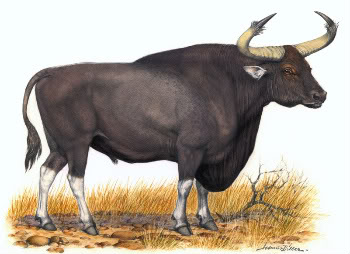 The Kouprey Bos sauveli, a species of wild ox. Illustration by: Helmut Diller. |
Wildlife declined from pre-1970s (when the conflict began) to 2005, but the most measured declines occurred in the 1970s—when the conflict was at its worst. The researchers found that 14 of 18 species declined, while five disappeared altogether, including the Asian elephant, the kouprey, Eld’s deer, hog deer, and Siamese crocodile. Before the conflict arrived in Sre Chis, the villagers only sold one species to outside markets—the guar—but by the 1970s seven more species were being trafficked: elephants, banteng, Eld’s deer, hog deer, tiger, leopard and sun bear.
“It is clear to [the villagers] that there are fewer individuals of the species…and that they need to go further from the villages to find them,” Loucks said.
Shockingly every one of these species (or subspecies) is threatened with extinction according to the IUCN Red List, except the Indochinese leopard which hasn’t been surveyed. The sun bear is considered Vulnerable, while the Indochinese tiger, Asian elephant, Eld’s deer, and hog deer are all listed as Endangered. The Siamese crocodile, the banteng, a species of wild cattle, and a wild ox known as the kouprey are each Critically Endangered.
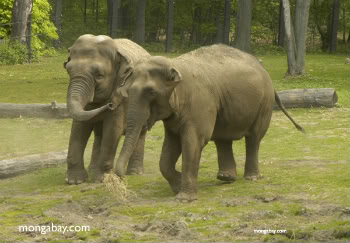 The Asian elephant has been hunted out of the forest around Sre Chis. Photo by: Rhett Butler. |
As related by Loucks and Mascia, these declines consistently followed societal changes brought on by war: additional firearms, the beginning of a wildlife trade for international markets, and a Khmer Rouge policy that actually mandated hunting. Prior to the 1970s villagers hunted with the crossbow, since guns were either illegal or difficult to obtain, but when the Khmer Rouge came to Sre Chis they handed out guns to locals and paid them to hunt. During the conflict, wildlife meat went to soldier on the front lines.
The conflict in Cambodia ended in 1991, although instability continued throughout the 1990s-but the interviewers discovered that wildlife declines continued due to the technological and social changes brought on by war. Instead of hunting for soldiers, the villagers had now begun to hunt for commercial sale in markets both in Cambodia and abroad.
“Documenting these impacts and the subsequent ripple effects in post-conflict society – shifting livelihood strategies and the decline of wildlife – allow us to understand the links between conflict and wildlife decline,” Loucks and Mascia said. “This sheds light on the importance of re-engaging with communities, empowering them to manage their resources, and providing economic opportunities soon after the cessation of conflict. With this information, we can design more effective conservation strategies, tailored to local conditions.”
Importance of conservation to postconflict society
The UN has drafted important guidelines for ‘disarmament, demobilization, and reintegration’ of combatants (known as DDR), but they don’t take into account the conservation of natural resources, according to Loucks and Mascia. Even though many conflicts begin with—or in some way involve—over-exploitation of a nation’s resources.
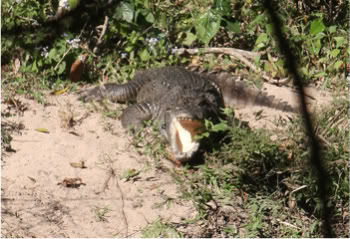 Critically Endangered Siamese crocodile in Thailand: the species has disappeared from the Sri Chis forests. Photo by: Rhett Butler. |
Therefore the authors suggest “that conservation investments in postconflict societies should be integrated within and support broader peace-building efforts targeting combatants, noncombatants, civil society organizations, and the state”.
Mascia goes on to say that “many conservation strategies are consistent with current approaches to peace-building, such as capacity-building for government agencies and local communities, fostering good governance and rule of law, and promoting alternative livelihoods and income generating activities. In societies where natural resources are a source of conflict, strengthening civil society and good governance in the environmental sector is necessary not just for effective conservation of biodiversity, but for peace-building generally.”
Loucks and Mascia see conservation as a tool to aid with disarmament in postconflict society by justifying confiscating weapons when used for illegal hunting. In addition, conservation organization act as important support for newly formed governments by “promoting rule of law; encouraging participatory and transparent decision making; and supporting other activities that foster good governance within the conservation sector and beyond,” according to the paper.
 While tigers still reside in the forest around Sri Chis, their population has declined according to interviews. Photo by: Martin Harvey with WWF. |
Furthermore, the authors argue, conservation groups have the capacity to monitor postconflict efforts to make certain both individuals and large-scale investments are not engaging in unsustainable natural resource exploitation. Instead of handing such postconflict countries over to international corporations for large-scale monoculture plantations, industrial agriculture or mining—which may degrade the environment and stoke further conflict—conservation organizations or civil society could manage or monitor environmental restoration projects.
Such restoration projects “would serve multiple purposes” the authors write, including “employment of both ex-combatants and noncombatants, enhanced delivery of ecosystem services to resource-dependent communities, critical habitat for wildlife, and reduced wildlife trade by providing alternative sources of income.”
Finally, the authors recommend that conservation groups be allowed to perform capacity-building at the community level in order to reach out to remote areas, places where a new government may not have influence or even means of communication. According to the paper, such programs “can empower local actors and strengthen local governance regimes, absorb ex-combatants into the labor force, and provide legal economic opportunities for ex-combatants and noncombatants alike.”
The people—not just the wildlife—of post-conflict nations would benefit greatly from increased conservation and environmental awareness, according to the paper.
“We believe that the UN, governments, civil society, and NGOs all have a role they can play to integrate natural resource conservation, biodiversity protection, and peace-building efforts from the local to national or global scale. To design conservation strategies that are both ecologically and socially sustainable, we need to build tailored solutions that bridge the traditional divide between security and the environment.” Loucks and Mascia told mongabay.com.
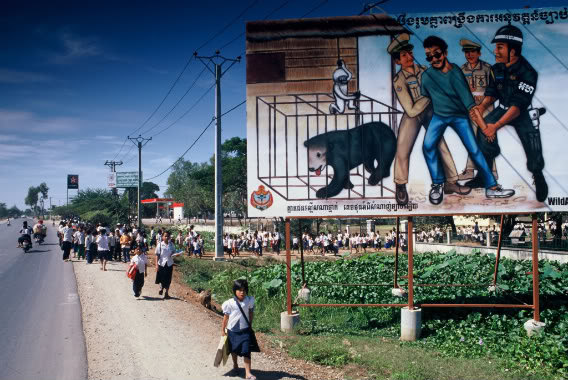
Phnom Penh, Cambodia. An anti-wildlife trade billboard by Wildlife Alliance outside a local school. Part of a government education program that aims to educate Cambodians about the country’s wildlife laws. Photo by: Adam Oswell of WWF.
Related articles
Illegal hunting in Laos takes toll on wildlife

(04/20/2009) Deep in the rugged mountains of Nam Et-Phou Louey National Protected Area (NEPL) on the Laos–Vietnam border, men smoke cigarettes and talk in hushed voices as they tramp through the forest. Approaching a baited trap, they hear the frantic snarls of an ensnared tiger. The tiger hangs by its front foot, suspended by a cable attached to a tree. The men shoot and make quick work of the tiger, removing its bones but leaving some of its carcass, including parts of its pelt, behind. The real money is no longer in tiger skins, but bones: the 10 to 12 kilograms of bone harvested from the adult tiger will yield $12,000-$15,000 in a region where per capita income is around $400 a year. Though the authorities are able to trace the weapon shells back to their village and locals know of the hunters’ haul, two years later the evidence has not been enough to hold the men accountable for their crimes.
80% of wars between 1950-2000 took place in biodiversity hotspots
(02/22/2009) 80 percent of the world’s major armed conflicts between 1950 and 2000 occurred in biodiversity hotspots, reports a study published in the journal Conservation Biology.
Cambodia could earn $100 million under climate deal
(11/06/2006) Cambodia could earn hundreds of millions of dollars through a global warming proposal under consideration this week at U.N. climate negotiations in Nairobi, Kenya. At talks last year in Montreal, a coalition of tropical developing countries lead by Papua New Guinea proposed a rainforest conservation compensation initiative whereby industrialized nations would pay them to protect their forests to offset heat-trapping gas emissions. After endorsements by the World Bank, the United Nations, and the United States, the plan will likely be discussed in greater detail at the Nairobi conference.
US ranks #7 in global forest loss, Cambodia has worst deforestation rate
(11/16/2005) Cambodia has the world’s highest deforestation rate, Brazil loses the largest area of forest annually, and Congo consumes more bushmeat than any other tropical country. These are among the findings from mongabay.com’s analysis of new deforestation figures from the United Nations.









